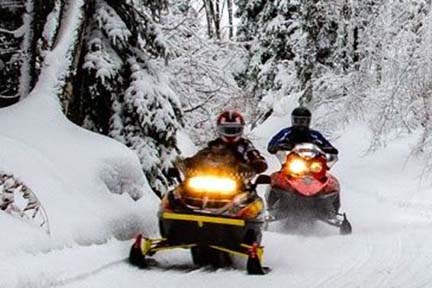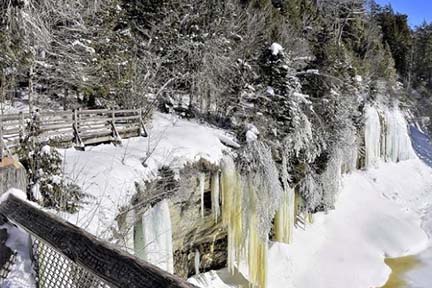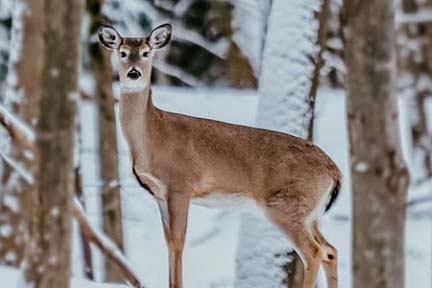| This week’s stories may reflect how the Department of Natural Resources has adapted to meet customer needs and protect public health and safety. Follow our COVID-19 response page for updates on access to facilities and programs.
We’ll continue to share news and information about the best ways to discover and enjoy Michigan’s natural and heritage resources! Here’s a look at some of this week’s stories:
See other news releases, Showcasing the DNR stories, photos and other resources at Michigan.gov/DNRPressRoom.
PHOTO FOLDER: Larger, higher-res versions of the images used below, and others, are available in this folder.
 Want to see more pictures like this, taken by Michigan state parks photo ambassador Karen Allmond at Tahquamenon Falls State Park in Chippewa County? Visit Instagram.com/MiStateParks to explore photos and learn more about the photo ambassadors! For more on the photo ambassador program, call Stephanie Yancer at 989-274-6182. Want to see more pictures like this, taken by Michigan state parks photo ambassador Karen Allmond at Tahquamenon Falls State Park in Chippewa County? Visit Instagram.com/MiStateParks to explore photos and learn more about the photo ambassadors! For more on the photo ambassador program, call Stephanie Yancer at 989-274-6182.
 How do I choose a good spot to fish? Live bait or artificial lures? Which is better, a hand auger or a power auger? What types of fish can I catch while ice fishing? How do I know if the ice is safe? How do I choose a good spot to fish? Live bait or artificial lures? Which is better, a hand auger or a power auger? What types of fish can I catch while ice fishing? How do I know if the ice is safe?
If you’re new to winter fishing and have questions like these, join our experts for a Facebook Q&A on ice fishing, 5 to 7 p.m. Tuesday, Feb. 15, on the DNR’s Facebook page.
Christian LeSage, a biologist with the DNR’s Aquatic Species and Regulatory Affairs Unit, and Scott Heintzelman, the DNR’s Central Lake Michigan Management Unit manager, will answer your questions and share insights and tips to get you started. LeSage and Heintzelman will be joined by conservation officers from the DNR Law Enforcement Division, who will be available to provide information on regulations and safety.
Questions? Contact Sierra Williams at 517-230-8788. |
 Blue jays, red-breasted nuthatches and northern cardinals are just a few of the birds providing a burst of color and activity across stark winter landscapes. Blue jays, red-breasted nuthatches and northern cardinals are just a few of the birds providing a burst of color and activity across stark winter landscapes.
Well-stocked bird feeders can attract such birds to your space during these months when natural food sources might be snow-covered or limited in supply. Keeping your feeders up into the spring, too, can aid birds on their long migrations north.
Keep in mind, though, that feeders may draw uninvited guests to your property, like rodents and white-tailed deer. While a beautiful sight, congregating deer can further the spread of chronic wasting disease, a contagious and fatal neurological disease that affects deer, elk and moose.
CWD is transmitted through direct animal-to-animal contact; that’s why it is critical to discourage deer from gathering around bird feeders. Make sure you’re familiar with baiting and feeding bans in place in the Lower Peninsula and CWD core areas in the U.P., aimed at reducing artificial food sources that lure deer. |
 Here are tips on how best to feed birds while keeping Michigan’s deer herd safe: Here are tips on how best to feed birds while keeping Michigan’s deer herd safe:
- Use tube feeders. These are best for black oil sunflower, mixed seed, safflower seed or peanuts, which attract chickadees, titmice, nuthatches, goldfinches, siskins, and purple and house finches.
- Use hopper feeders, best for safflower and sunflower seeds or cracked corn. These feeds attract all the species that visit tube feeders, plus larger birds like cardinals, jays, grackles and red-winged blackbirds.
- Use suet feeders to attract woodpeckers, titmice, nuthatches and chickadees, and the occasional wren, creeper and warbler.
- Don’t place seed directly on the ground or use platform feeders, which tend to attract deer and other unwanted guests. Mess-free birdseed options, which help keep the ground clean, are available.
- Fence in your feeders, if possible, to prevent deer from reaching them.
Get more bird feeding tips from the DNR and Audubon Great Lakes. For questions or concerns about feeding and baiting regulations, contact your local DNR customer service center. |
 Ready for a classic Michigan winter outdoor experience? How about the annual Winter Free Fishing Weekend, this year on Saturday and Sunday, Feb. 19 and 20 – two full days for family and friends to fish without a license, though all other fishing regulations still apply. Ready for a classic Michigan winter outdoor experience? How about the annual Winter Free Fishing Weekend, this year on Saturday and Sunday, Feb. 19 and 20 – two full days for family and friends to fish without a license, though all other fishing regulations still apply.
Michigan has celebrated Free Fishing Weekend every year since 1986 as a way to promote awareness of the state’s world-class fishing and vast aquatic resources. With more than 3,000 miles of Great Lakes shoreline, tens of thousands of miles of rivers and streams, and 11,000 inland lakes, Michigan and fishing are a perfect match.
Before heading out to your favorite spot, make sure you and your fishing buddies are prepared for winter weather. Take a few minutes to review our ice safety tips at Michigan.gov/IceSafety, too.
If you already have a fishing license, the Winter Free Fishing Weekend is a great opportunity to introduce someone new to Michigan fishing. Who knows? They might just get hooked on this popular pastime!
Another bonus: During Free Fishing Weekend, the DNR waives the need for the Recreation Passport, usually required for vehicle access to Michigan’s 103 state parks and more than 1,300 DNR-managed boating access sites.
Get more details on the weekend at Michigan.gov/FreeFishing. Brush up on current fishing regulations at Michigan.gov/DNRDigests.
Questions? Contact Sierra Williams at 517-230-8788. |
 The first African American pilots trained by the U.S. Army Air Corps earned their wings at Tuskegee Army Airfield in Alabama during World War II. Starting in spring 1943, fighter pilots from Tuskegee received advanced training in Michigan at Selfridge Field near Mt. Clemens and Oscoda Army Airfield on the Lake Huron shore. Sadly, 15 Tuskegee Airmen, including Lt. Frank Moody, lost their lives while training here. The first African American pilots trained by the U.S. Army Air Corps earned their wings at Tuskegee Army Airfield in Alabama during World War II. Starting in spring 1943, fighter pilots from Tuskegee received advanced training in Michigan at Selfridge Field near Mt. Clemens and Oscoda Army Airfield on the Lake Huron shore. Sadly, 15 Tuskegee Airmen, including Lt. Frank Moody, lost their lives while training here.
On April 11, 1944, Lt. Moody was killed when his Bell P-39 Airacobra crashed in Lake Huron. Exactly 70 years later, on April 11, 2014, David and Drew Losinski discovered the wrecked airplane north of Port Huron. They have been working with Michigan’s state maritime archaeologist, Wayne Lusardi, from the Michigan History Center, and the National Museum of the Tuskegee Airmen to archaeologically document and recover the aircraft wreckage, and conserve and exhibit the artifacts in Detroit.
A memorial was dedicated in August 2021 at International Flag Plaza in Port Huron to honor those 15 Tuskegee Airmen, whose impact on northeast Michigan, contribution to the war effort and ultimate sacrifice will long be remembered here and across the nation.
Thanks to the assistance of DNR conservation officers in accomplishing the project, the stories of Lt. Moody, the Tuskegee Airmen and the archaeological work are told in a new episode of “Wardens” airing Feb. 18 on the Outdoor Channel. You can preview some highlights.
Outdoor Channel and Wolf Creek Productions also have made two additional segments available:
|
 The Tuskegee aircraft – currently in many hundreds of pieces – is being systematically mapped and recovered over time by Michigan History Center staff. Following recovery, the artifacts require conservation treatment, which is being done in Alpena and Detroit. All of the aircraft materials are owned by the state of Michigan and will be loaned to the Tuskegee Museum for exhibit. The Tuskegee aircraft – currently in many hundreds of pieces – is being systematically mapped and recovered over time by Michigan History Center staff. Following recovery, the artifacts require conservation treatment, which is being done in Alpena and Detroit. All of the aircraft materials are owned by the state of Michigan and will be loaned to the Tuskegee Museum for exhibit.
Episodes of “Wardens” air on the Outdoor Channel every Friday at 8:30 and 11:30 p.m., Saturday at 5:30 p.m., Monday at 5:30 p.m. and 2:30 a.m. and Tuesday at 7:30 a.m. (all times EST). To get the Outdoor Channel, ask your local TV service provider or go to OutdoorChannel.com, MyOutdoorTV.com, Amazon Prime or call 1-855-44OUTDOOR. More than 52 episodes have featured the state of Michigan and have had more than 30 million viewers.
Questions? Contact Dave Haupt at 517-420-0819.
Note: This Showcasing the DNR story from October 2021 tells more about efforts to recover, conserve and memorialize this Michigan connection to Tuskegee Airmen history. |
 Coyotes can be found statewide in just about any habitat, including urban and suburban neighborhoods. People often unintentionally create suitable habitat for adaptable wildlife like coyotes, foxes, rabbits, squirrels, deer, geese and turkeys, making it easier for these animals to expand beyond traditional wildlife habitat boundaries. Coyotes can be found statewide in just about any habitat, including urban and suburban neighborhoods. People often unintentionally create suitable habitat for adaptable wildlife like coyotes, foxes, rabbits, squirrels, deer, geese and turkeys, making it easier for these animals to expand beyond traditional wildlife habitat boundaries.
While coyotes are an integral part of our ecosystem, some residents may consider them a nuisance.
“If there’s an unwelcome coyote in the area, look for possible attractants that might make the area appealing,” said Holly Vaughn, wildlife outreach and engagement manager with the DNR.
“Is there a nearby patch of woods or natural area that provides shelter? Are there food sources, such as bird feeders, that attract small mammals or an abundance of rabbits?” Vaughn said. “Where possible, modify or remove the things that are attracting coyotes or the small mammals they prey on.” |
 Changes could be as simple as removing bird feeders and keeping trash cans indoors until the morning of trash pickup. You also can try “hazing” tactics that can help maintain coyotes’ natural fear of people. All of these efforts reduce opportunities for coyotes or other animals to get used to finding ready food sources. Changes could be as simple as removing bird feeders and keeping trash cans indoors until the morning of trash pickup. You also can try “hazing” tactics that can help maintain coyotes’ natural fear of people. All of these efforts reduce opportunities for coyotes or other animals to get used to finding ready food sources.
“You want to make it an uncomfortable and unpleasant experience for the coyote to be near people,” said Vaughn. “Coyotes that become accustomed to being around people may become bolder as their fear lessens. It’s good to remind them that people should be avoided.”
If you’ve tried these tactics but coyotes are still hanging around your property, or you’re concerned about their presence in the area, contact a nuisance wildlife control business for help. These businesses are permitted by the DNR to remove certain wildlife, including coyotes, from private property.
If hunting is allowed in your area, coyote hunting season is open year-round statewide, with no bag limit. Check local laws and review the statewide hunting and trapping regulations for coyotes in the current Fur Harvester Digest at Michigan.gov/Trapping.
Learn more about coyotes and how to handle conflicts with wildlife at Michigan.gov/Wildlife.
Questions? Contact the DNR Wildlife Division at 517-284-9453. |
|




